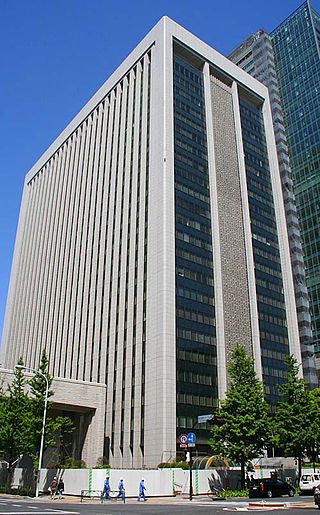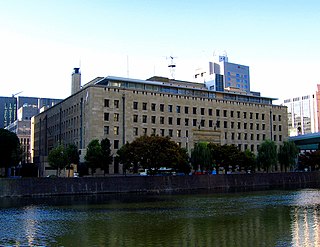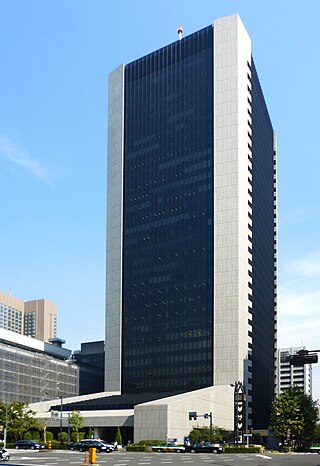A keiretsu is a set of companies with interlocking business relationships and shareholdings that have dominated the Japanese economy since the second half of the 20th century. In the legal sense, it is a type of informal business group that is loosely in an organized alliance within the social world of Japan's business community. It rose up to replace the zaibatsu system that was dissolved in the occupation of Japan following the Second World War. Though their influence has shrunk since the late 20th century, they continue to be important forces in Japan's economy in the early 21st century.

Mizuho Financial Group, Inc., abbreviated as MHFG, or simply called Mizuho, is a banking holding company headquartered in the Ōtemachi district of Chiyoda, Tokyo, Japan. The name "mizuho (瑞穂)" literally means "abundant rice" in Japanese and "harvest" in the figurative sense. Upon its founding, it was the largest bank in the world by assets. It is considered a systemically important bank by the Financial Stability Board.

Mizuho Bank, Ltd. is the integrated retail and corporate banking unit of Mizuho Financial Group, the third largest financial services company in Japan, with total assets of approximately $1.8 trillion in 2017. Mizuho is one of the three so-called Japanese "megabanks". Mizuho Bank provides financial products and services to a wide range of clients, including individuals, small and medium-sized enterprises, large corporations, financial institutions and public sector entities. Its headquarters office building is located in the Otemachi district of Chiyoda, Tokyo.
The Dai-ichi Kangyo Bank, Limited, abbreviated as DKB, was one of the largest banks in the world during the latter half of the 20th century. Dai-Ichi Kangyo Bank was created in 1971 by a consortium of two banks: Dai-Ichi Bank, Japan's oldest bank, and Nippon Kangyo Bank, a state financial institution that granted long-term loans to industry and agriculture.

The Fuji Bank, Limited was one of Japan's major banks during the post–World War II era. It combined with Dai-Ichi Kangyo Bank and the Industrial Bank of Japan in 2000 to form Mizuho Financial Group, and changed its name to Mizuho Corporate Bank in 2002 after transferring its retail banking operations to Mizuho Bank.

The Mitsubishi Bank, Ltd. was a major Japanese bank that served as the main bank for the Mitsubishi conglomerate/keiretsu. It merged with The Bank of Tokyo in 1996 to form The Bank of Tokyo-Mitsubishi.
Mizuho Corporate Bank, Ltd., or MHCB, was the corporate and investment banking subsidiary of Mizuho Financial Group, the second-biggest Japanese financial services conglomerate, prior to the reintegration of investment banking services under the Mizuho Bank name in July 2013.

The Sumitomo Bank, Limited was a major Japanese bank based in Osaka and a central component of the Sumitomo Group. It merged with Sakura Bank on April 1, 2001, to form Sumitomo Mitsui Banking Corporation.

The Sakura Bank, Limited (さくら銀行, Sakura Ginkō) was a Japanese bank based in Tokyo and Kobe. It was formed in April 1990 as the Mitsui Taiyo Kobe Bank (MTKB) by the merger of Mitsui Bank (founded 1876) and Taiyo Kobe Bank (founded 1973). The Sakura Bank name was adopted in April 1992.
Trust & Custody Services Bank, Ltd. is a Japanese bank that provides asset administration for banks and insurance companies. As of August 2017, it had 50 trillion yen in capital. In July 2020 Trust & Custody Services Bank merged with the Japan Trustee Services Bank to form Japan Custody Bank.
The main elements of Japan's financial system are much the same as those of other major industrialized nations: a commercial banking system, which accepts deposits, extends loans to businesses, and deals in foreign exchange; specialized government-owned financial institutions, which fund various sectors of the domestic economy; securities companies, which provide brokerage services, underwrite corporate and government securities, and deal in securities markets; capital markets, which offer the means to finance public and private debt and to sell residual corporate ownership; and money markets, which offer banks a source of liquidity and provide the Bank of Japan with a tool to implement monetary policy.
The engine of Japanese economic growth has been private initiative and enterprise, together with strong support and guidance from the government and from labor. The most numerous enterprises were single proprietorships, of which there were more than 4 million in the late 1980s. The dominant form of organization, however, is the corporation. In 1988 some 2 million corporations employed more than 30 million workers, or nearly half of the total labor force of 60.1 million people. Corporations range from large to small, but the favored type of organization is the joint-stock company, with directors, auditors, and yearly stockholders' meetings.
Fuyo Group is a Japanese keiretsu descended from the Yasuda zaibatsu, Asano zaibatsu and Okura zaibatsu. They are major business grouping in Japan up to World War II. In 1948, Yasuda was dismantled, with its key financial arm Yasuda Bank becoming Fuji Bank.

Mizuho Trust & Banking Co., Ltd. is the trust banking arm of Mizuho Financial Group.
The DKB Group or the Dai-Ichi Kangyo Group was the largest Japanese keiretsu in the late 1990s.
Mizuho Capital Co., Ltd. is the venture capital firm affiliated to Mizuho Bank, the second-largest Japanese bank in terms of assets. The firm has headquarters in Tokyo.

The Mizuho Bank Uchisaiwaichō Head Office Building is a 143 m (469 ft) tall office skyscraper in Tokyo, Japan. At 38 stories the building is the 86th tallest building in Tokyo. It contains 1.4 million sq ft of office space, 100% of which is now occupied by Mizuho Bank, the consumer banking arm of the second-largest Japanese financial conglomerate Mizuho Financial Group, while still called the DKB Head Office from time to time.
Mizuho Americas was established on July 1, 2016 as a US bank holding company, as the American corporate and investment banking arm of the Tokyo-based Mizuho Financial Group.
Mitsui Bank, Ltd. was a major Japanese bank from 1876 to 1990. It merged with Taiyo Kobe Bank to form Mitsui Taiyo Kobe Bank (MTKB), which was renamed The Sakura Bank in April 1992. Sakura Bank is now part of Sumitomo Mitsui Banking Corporation (SMBC).








